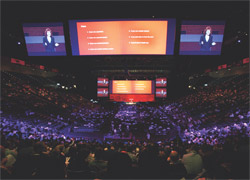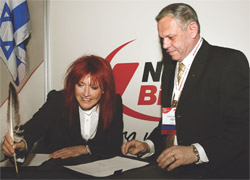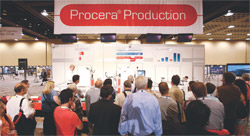Nobel Biocare Conference Explores Education, Showcases Live Surgeries
An 8-hour live surgery and the introduction of patients who had received maxillofacial rehabilitations using implant surgery were among the highlights at the Nobel Biocare World Conference 2007. Held in Las Vegas, NV, from May 20 to May 24, the conference, hosted by Nobel Biocare AB (Göteborg, Sweden), was attended by nearly 10,000 participants, including dentists, physicians, scientists, and patients, among others.
According to Heliane Canepa, president and CEO of Nobel Biocare, the conference was so packed that Nobel Biocare had to increase the number of sessions. “We had to add 44 more hands-on sessions, and even those are sold out,” she announced in her introductory remarks.
Education, science, and state-of-the-art technology were the focus of the conference. “Nobel Biocare was raised on science and education, and I am determined to continue this,” Ms. Canepa said.
The 5-day conference reinforced Ms. Canepa’s focus. The main sessions featured 35 live treatments transmitted via satellite from seven countries, including the first live, real-time broadcast from the University of Peking in China, and translated into eight languages. Transmissions were viewable in the MGM Grand auditorium, at a multitude of stations in the hotel, and even in the attendees’ hotel rooms. Clinicians performed solution-based treatments with the newest techniques, such as Teeth-in-an-Hour™, the NobelActive™ system, the Curvy Abutment™, and Shorty™ implants, among others. Outside of the auditorium, participants were offered a variety of interactive options to enhance their learning experience. Nearly 340 internationally recognized dental experts participated in this effort. One-on-one sessions afforded the chance to discuss the treatment plan of their cases with industry experts; more than 15,000 sessions were booked. In the hands-on-sessions, under expert guidance, participants were instructed on how to work with Nobel Biocare’s products and solutions. Workshops included in-depth analysis and informed debate as well as more structured lectures. Even the lunch hour was edifying, featuring a series of debates in which authorities in dentistry contended on topics in the field of esthetic dentistry.
Each day of the conference had a different theme. They were, in chronological order:
• Focus on the Patient;
• Major Surgeries;
• Maxillofacial;
• Procera®; and
• Esthetics.
MAXILLOFACIAL CONCEPT
Patients who had lost part of their faces because of an accident, defect, or disease were presented at the conference to show their improvement after surgery. In the past, these patients would have very limited options, according to Dr. Edmond Bedrossian, director of implant surgical training at University Pacific in San Francisco. He listed older ways used to treat these patients, including an acrylic prosthesis attached to what are “basically eyeglasses,” and silicone, which was better colored to match the skin tone but was held on by adhesive. “As you can imagine, as soon as the patient started to laugh, the margins would open up,” said Dr. Bedrossian. “They were constantly aware and conscious of it.”
The new way to treat these patients, which was showcased at the conference, is a maxillofacial concept based on the Brånemark System®, a full range of prosthesis components, and 3-dimensional (3-D) diagnosis and planning software. According to the Nobel Biocare booklet Maxillofacial Concept, “it was Per-Ingvar Brånemark’s discovery that titanium is biocompatible and actually fuses over time with bone that led to new innovative treatment solutions.” This includes the use of dental implants as anchors, eliminating the need for loose prostheses; and the use of 3-D software, which allows the maxillofacial team to assess the patient’s maxillofacial anatomy, including hard and soft tissues from CT scans.
“Unfortunately, this patient group is nondiscriminating,” said Dr. Bedrossian. “There is a 20-year old with maxillofacial deformities caused by the removal of a tumor. How can we help? By using maxillofacial implants, we are able to go ahead and fix implants to strategic areas of whatever type of bone is available,” he continued. “We are able to create retention in the bones, such as bars, which will then secure the prosthesis and allow the patient to not constantly think about it.”
Professor Per-Ingvar Brånemark, who Ms. Canepa introduced as the inventor of modern implantology, stressed the importance of interdisciplinary work in the advancement of these implants.
“Medicine and dentistry should work together to improve the life of fellow beings,” said Dr. Brånemark. “I will introduce the possibility to provide the lost components of the cranial maxillofacial function. I will do that, not by academic speculation, but by showing you real, living patients who we have treated together between dentistry, medicine, and technology and whose lives now will be capable of improving, even for those who would not otherwise be provided with a normal, happy smile.”
Patients, speaking mostly in Portuguese (with English subtitles), recounted their experiences, and the audience was shown before and after pictures.
On the third day of the conference, one of these surgeries was performed live by Drs. Peter Bucher, Beat Hammer, Philipp Neff, Dennis Rohner, and Gert Wittwer, and transmitted in real time from Switzerland. The micro-vascular and bone-graft surgery included taking a bone graft from the leg for use in rehabilitating a mandibular defect; joining an artery and vein taken with the bone graft to an artery and vein in the neck; and installing a screw-retained implant-supported restoration. The day-long surgery clearly stands as one of the many highlights of the conference.
EDUCATING DENTISTS, PATIENTS, AND DENTAL STUDENTS
Nobel Biocare added two more universities, Hadassah in Israel and Ho Chi Mihn in Vietnam, to its Nobel Biocare University Partner program at the conference. Ms. Canepa affirmed that she believed education was an integral part of improving patients’ lives.
“Twenty years ago, everyone believed that implant dentistry could become a part of undergraduate curriculum very quickly. But this did not happen. The first implant patient was treated 42 years ago. Is it right that someone starting dental school today and graduating in 2012 may not know how to treat a patient with implants and esthetics? No, it’s not,” she said.
Nobel Biocare, according to Ms. Canepa, trained over 350,000 dental professionals in 2006 and has 20 University Partners, including the additions.
“Our strategy is to give basic education back to universities, where it belongs,” she explained. “That’s why we started the Nobel Biocare University Partner program. [Our partners] are now teaching treatments for all indications and making sure that implants and CAD/CAM are part of the treatment planning.”
Ms. Canepa said that Nobel Biocare is working toward implementation of new curricula that will include implants. “We are facilitating the implementation of new curricula by providing knowledge and tools. We are developing digital learning, learning through Podcasts, and simulation exercises. We are driving a paradigm shift in dental education for a new generation. My mission is to form a global network of universities with a free-flowing exchange of knowledge, students, and faculty,” she said.
Furthering its emphasis on education, the conference had a series of hands-on sessions in which participants could learn firsthand how to correctly use Nobel Biocare’s products. Sessions included tutorials on NobelGuide™, NobelActive™, and Procera.
LUNCHTIME DEBATES
Four debates, which were viewed as highly successful by show attendees, took place throughout the conference. The first debate, Graft vs Graftless, asked if bone grafting was essential for a successful implant treatment where bone quality/quantity is limited. The second, PFM Crown vs All-Ceramic Restoration, asked: What contributes more to a favorable esthetic result: a PFM crown or an all-ceramic restoration? The third debate, TiUnite® vs SLActive®, posed the question: Is TiUnite® more osseoconductive than a SLActive® surface? The final debate, Screw-retained vs Cemented, asked: Is a screw-retained prosthesis more favorable to soft and hard tissue than a cemented one?
PRODUCT PREMIERS
The conference premiered the use of NobelActive, a new implant design with an innovative thread pattern. It is a one-stage implant and has a self-drilling capability to facilitate drilling protocols in areas of narrower osteotomy. NobelActive was designed for increased soft tissue volume at the head of the implant, resulting in improved esthetics.
“We have been working on it for some time,” said Dr. Werner Hotz, certified specialist for implantology and honorary president of the German Centre for Oral Implantology. “It’s a brand new way to do implants.”
The Shorty implant was presented on the third day of the conference as a solution for the excessively resorbed jaw. According to the Nobel Biocare booklet Solution with Implants, the Shorty implant is designed specifically for working where bone height is limited. It is available for the Brånemark System® Groovy and NobelSpeedy™ Groovy.
At the World Conference press conference, a participant asked Dr. Hotz why he chose Nobel Biocare’s implants and systems to work with.
“Nobel Biocare makes the template for osseo surgery but also the template for the technician so he is able to create a literal model of the patient’s mouth, a literal situation, and make the bridge work. The technician is able to make a provisional prosthesis and provisional bridgework immediately.” said Dr. Hotz. “And the accuracy [of the system is such that] we can make certain treatments predictable to less than a millimeter.”
Dr. Christopher Marchack added: “[Nobel Biocare] has 42 years experience working with implants. What other company out there has that? There isn’t one. But for me, it’s the studies that really make the difference. Every treatment has been given a long-term study—those university studies make me confident placing these implants.”
POSTER AWARDS
The World Conference Poster Program was designed to provide researchers, clinicians, technicians, and ceramists with the opportunity to share their expertise with Nobel Biocare’s solution-based therapy using all-ceramic crowns, bridges, and implants. There were over 300 posters submitted from around the world, all of which were reviewed by the Conference’s Scientific Awards Committee, chaired by Carol Lefebvre, DDS. One of the highlights of the penultimate day of the conference was the presentation of awards to the winning posters (see Table).
REACHING HIGHER
While the echoes of the 2007 World Conference are still loud for those who attended, Ms. Canepa is already looking toward the next conference. “Don’t ask me what we are doing in 2009,” she said. “Something higher. In 2003, we had 2,600 participants. In 2005, we had 6,000 participants. We always go higher.”
 |  | |
| Figure 1 Nobel Biocare President and CEO Heliane Canepa making her introductory remarks | Figure 2 Nobel Biocare President and CEO Heliane Canepa and Hadassah University Dean of the Faculty of Dental Medicine Adam Stabholz formalize the school's status as a University Partner. | |
 | ||
| Figure 3 Participants at a Procera learning session. |



